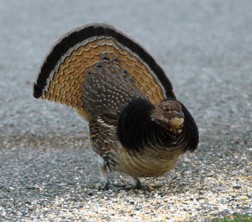Bird Tails
- Share
- Tweet
- Pin
- Share
A Saturday afternoon hike in early January to enjoy nature along one of those rare narrow, graveled roads near our home, bordered closely with trees and shrubs and not used frequently enough in winter to warrant snow plowing, turned up a sad discovery. Lying face downward on the ground, tail fanned to perfection, body feathers all arranged neatly as though the creature simply died in its tracks, was a Ruffed Grouse. Undoubtedly the bird collided with a car.
Judging by the shorter length of the tail feathers and the fact that the two central feathers did not have black bands near their tips, I suspect the bird may have been a female. Generally, but not always, male Ruffed Grouse tail feathers tend to be slightly longer and also more commonly they are all adorned with a black band. I left the bird exactly as I found it, fully expecting it to be discovered and the flesh eaten by some wild animal, a good example of nature’s recycling. Come early summer, no doubt some of the small songbirds’ nests along that stretch of road will contain grouse feathers too.

A male Ruffed Grouse eats cracked corn while displaying its beautiful feathers to attract a nearby female.
My leisurely trek continued eastward along a beautiful stone fence-line and was soon momentarily halted by a few crows flying overhead. One look at their moderately long and fanned tails, gently rounded at the tips, was convincing evidence that they weren’t Ravens. Ravens’ tails are distinctly wedge-shaped when extended outward as the birds fly.
The more one thinks about birds’ tails the more you realize how important they are to the birds as well as the birdwatchers. One tail feather is referred to as a rectrix (REK-trix) while all of the tail feathers of one bird are referred to collectively as the rectrices (REK-tri-sees). It’s interesting to note that, in spite of humans not having tails, we do have tailbones. Even more fascinating is the scientific name of the tailbone, coccyx (KOK-siks) from the Greek word “kokkux” – the Cuckoo – the thought being that the tailbone of a person is shaped like the bill of a Cuckoo.
Examine the lives of different species of birds and you will be amazed at the dozens of interesting and very specific uses of their tails. With the Ruffed Grouse so freshly in mind, not only does the fanned tail serve as an efficient rudder helping to safely steer the bird at high speeds around and between tree trunks and branches, but the resplendent strutting cock bird, tail so magnificently outstretched, surely relies upon this beautiful adornment in wooing his lady love.
The spread tails of many birds add lift to their flight. A tail fanned widely and downward serves as a brake when a bird comes in for a landing. Compared to the generally short tails of ducks, being rather straight fliers, the tails of crows and Northern Harriers, for example, are quite long and very efficient in that these birds are capable of performing some spectacular “flip-flops” and “loop-the-loops” during their courtship flight displays.
The extremely stiff tail feathers of a woodpecker serve as a prop, a third leg of support, when the bird clings to trees in search of food. Some birds’ rectrices move in perfect synchronization with their singing almost as though they were helping to push or pump out the notes. I’ve often wondered whether they could sing equally as well minus their tails.
I did discover by accident that a Dark-eyed Junco can fly and land quite nicely without the aid of a tail. Years ago while banding birds one spring I became a bit careless, out of monotony and routine, as I was securing the band to a Junco’s leg. I wasn’t quite finished with the task when all of a sudden the bird flitted in order to gain its freedom. Just that fast I grabbed for the bird and ended up with its entire tail in my hand, minus the bird. Oh, I felt badly and would like to have been able to glue all 12 rectrices back into place.
I did see the bird in our yard at the feeders for several days following the incident and it appeared to maneuver without apparent difficulty. Later I was relieved to learn that the bird within a few months, through natural regeneration, had a new tail grown back into place. In telling Charlotte this story she replied, with her instant wit, “Maybe the bird could have flown to a ‘retail store’ and had a new one installed!”

This Killdeer fans its tail to shield the eggs that are ready to hatch.
An unusual and exotic whinnying sound is made by both male and female Common Snipes, especially during their spring courtship. I first heard the sound at night when we boys used to fish for suckers with our dip nets from the city bridge in Kewaunee that spanned the Kewaunee River. Not once did we associate that delightful spring musicale with a bird!
Years later, by firsthand experience during daylight hours, I watched the Snipes gain altitude, up to 300 or more feet, then go into a rather steep dive in order to gain speed. Later I read in a reference book that it was the strong rush of air against the two stiff outer tail feathers spread apart, one on each side of the tail, which produced the mysterious and lovely descending music.
Most songbirds have 12 tail feathers. Some including the Ruby-throated Hummingbird, Chimney Swifts and Cuckoos have 10, while the Ruffed Grouse sports 16; the Ring-necked Pheasant (imported from China) 18 and the American White Pelican 24.
Frequently it is the ornamentally decorated tail, such as on the Peacock, or the long flowing rectrices of, for example, the Swallow-tailed Kites or Scissor-tailed Flycatchers that are such attractive and positive field marks in identifying the birds. Roger Tory Peterson, in describing the adult Bald Eagle, said that it is “all field mark!”
Charlotte and I have fond memories of photographing a nesting Killdeer and watching her slowly raise and spread her tail threateningly when we got too close. The striking, highly visible cinnamon-colored rump patch, extending from the similar color of the bases of her rectrices, was her warning to us. Without uttering a sound she was telling us to “Scram!”
The more one watches birds the more you realize the importance of their tails as aids to identification – the tails of hawks in flight, various white tail markings on many of the smaller songbirds, and even the movements of their tails, such as the tail bobbing of the Eastern Phoebe, Hermit Thrush, and Cape May Warbler.
Come spring and the arrival of more birds, I think we’ll flip a coin. Heads we’ll work in the garden, and tails we’ll go birdwatching.

